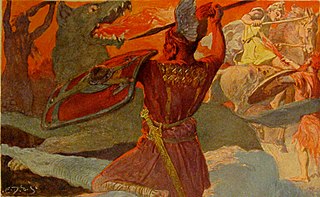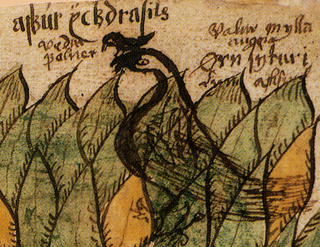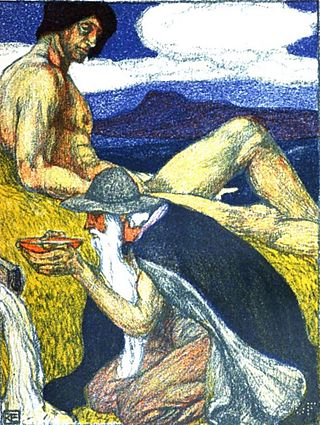
In Norse mythology, Ash and Embla —male and female respectively—were the first two humans, created by the gods. The pair are attested in both the Poetic Edda, compiled in the 13th century from earlier traditional sources, and the Prose Edda, composed in the 13th century. In both sources, three gods, one of whom is Odin, find Ask and Embla and bestow upon them various corporeal and spiritual gifts. A number of theories have been proposed to explain the two figures, and there are occasional references to them in popular culture.

The Norns are deities in Norse mythology responsible for shaping the course of human destinies.

In Norse mythology, Verðandi, sometimes anglicized as Verdandi or Verthandi, is one of the norns. Along with Urðr and Skuld, Verðandi makes up a trio of Norns that are described as deciding the fates (wyrd) of people.

Yggdrasil is an immense and central sacred tree in Norse cosmology. Around it exists all else, including the Nine Worlds.

In Norse mythology, the Nine Mothers of Heimdallr are nine sisters who gave birth to the god Heimdallr. The Nine Mothers of Heimdallr are attested in the Prose Edda, written in the 13th century by Snorri Sturluson; in the poetry of skalds; and possibly also in a poem in the Poetic Edda, a book of poetry compiled in the 13th century from earlier traditional material. Scholars have debated what being "born of nine mothers" implies and have sought to connect the notion to other European folk motifs. Scholars have theorized that Heimdallr's Nine Mothers may be identical to the Nine Daughters of Ægir and Rán, who personify waves. In turn, Heimdallr would be born of the sea.

In Norse mythology, Garmr or Garm is a wolf or dog associated with both Hel and Ragnarök, and described as a blood-stained guardian of Hel's gate.

Gullveig is a female figure in Norse mythology associated with the legendary conflict between the Æsir and Vanir. In the poem Völuspá, she came to the hall of Odin (Hár) where she is speared by the Æsir, burnt three times, and yet thrice reborn. Upon her third rebirth, she began practicing seiðr and took the name Heiðr.

In Norse mythology, Vígríðr or Óskópnir is a large field foretold to host a battle between the forces of the gods and the forces of Surtr as part of the events of Ragnarök. The field is attested in the Poetic Edda, compiled in the 13th century from earlier traditional material, and in the Prose Edda, written by Snorri Sturluson in the 13th century. The Poetic Edda briefly mentions the field as where the two forces will battle, whereas the Prose Edda features a fuller account, foretelling that it is the location of the future death of several deities before the world is engulfed in flames and reborn.

Wyrd is a concept in Anglo-Saxon culture roughly corresponding to fate or personal destiny. The word is ancestral to Modern English weird, whose meaning has drifted towards an adjectival use with a more general sense of "supernatural" or "uncanny", or simply "unexpected".
A hörgr or hearg is a type of altar or cult site, possibly consisting of a heap of stones, used in Norse religion, as opposed to a roofed hall used as a hof (temple).

Urðarbrunnr is a well in Norse mythology. Urðarbrunnr is attested in the Poetic Edda, compiled in the 13th century from earlier traditional sources, and the Prose Edda, written in the 13th century by Snorri Sturluson. In both sources, the well lies beneath the world tree Yggdrasil, and is associated with a trio of norns. In the Prose Edda, Urðarbrunnr is cited as one of three wells existing beneath three roots of Yggdrasil that reach into three distant, different lands; the other two wells being Hvergelmir, located beneath a root in Niflheim, and Mímisbrunnr, located beneath a root near the home of the frost jötnar. Scholarly theory and speculation surrounds the well.

Máni is the Moon personified in Germanic mythology. Máni, personified, is attested in the Poetic Edda, compiled in the 13th century from earlier traditional sources, and the Prose Edda, written in the 13th century by Snorri Sturluson. Both sources state that he is the brother of the personified sun, Sól, and the son of Mundilfari, while the Prose Edda adds that he is followed by the children Hjúki and Bil through the heavens. As a proper noun, Máni appears throughout Old Norse literature. Scholars have proposed theories about Máni's potential connection to the Northern European notion of the Man in the Moon, and a potentially otherwise unattested story regarding Máni through skaldic kennings.

Norse cosmology is the account of the universe and its laws by the ancient North Germanic peoples. The topic encompasses concepts from Norse mythology, such as notions of time and space, cosmogony, personifications, anthropogeny, and eschatology. Like other aspects of Norse mythology, these concepts are primarily recorded in the Poetic Edda, a collection of poems compiled in the 13th century, and the Prose Edda, authored by Icelander Snorri Sturluson in the 13th century, who drew from earlier traditional sources. Together these sources depict an image of Nine Worlds around a cosmic tree, Yggdrasil.

In Norse mythology, Gjallarhorn is a horn associated with the god Heimdallr and the wise being Mímir. The sound of Heimdallr's horn will herald the beginning of Ragnarök, the sound of which will be heard in all corners of the world. Gjallarhorn is attested in the Poetic Edda, compiled in the 13th century from earlier traditional material, and the Prose Edda, written in the 13th century by Snorri Sturluson.

Sól or Sunna is the Sun personified in Germanic mythology. One of the two Old High German Merseburg Incantations, written in the 9th or 10th century CE, attests that Sunna is the sister of Sinthgunt. In Norse mythology, Sól is attested in the Poetic Edda, compiled in the 13th century from earlier traditional sources, and the Prose Edda, written in the 13th century by Snorri Sturluson.

In Norse mythology, Veðrfölnir is a hawk sitting between the eyes of an unnamed eagle that is perched on top of the world tree Yggdrasil. Veðrfölnir is sometimes modernly anglicized as Vedrfolnir, Vedurfolnir or Vetrfolnir.

Skuld is a Norn in Norse mythology. Along with Urðr and Verðandi, Skuld makes up a trio of Norns that are described as deciding the fates of people. Skuld appears in at least two poems as a Valkyrie.

In Norse mythology, Mímisbrunnr is a well associated with the being Mímir, located beneath the world tree Yggdrasil. Mímisbrunnr is attested in the Poetic Edda, compiled in the 13th century from earlier traditional sources, and the Prose Edda, written in the 13th century by Snorri Sturluson. The well is located beneath one of three roots of the world tree Yggdrasil, a root that passes into the Jötunheimr where the primordial plane of Ginnungagap once existed. In addition, the Prose Edda relates that the water of the well contains much wisdom, and that Odin sacrificed one of his eyes to the well in exchange for a drink. In the Prose Edda, Mímisbrunnr is mentioned as one of three wells existing beneath three roots of Yggdrasil, the other two being Hvergelmir, located beneath a root in Niflheim, and Urðarbrunnr.

In Norse mythology, Sága is a goddess associated with the location Sökkvabekkr. At Sökkvabekkr, Sága and the god Odin merrily drink as cool waves flow. Both Sága and Sökkvabekkr are attested in the Poetic Edda, compiled in the 13th century from earlier traditional sources, and in the Prose Edda, written in the 13th century by Snorri Sturluson. Scholars have proposed theories about the implications of the goddess and her associated location, including that the location may be connected to the goddess Frigg's fen residence Fensalir and that Sága may be another name for Frigg.

Norse, Nordic, or Scandinavian mythology is the body of myths belonging to the North Germanic peoples, stemming from Old Norse religion and continuing after the Christianization of Scandinavia, and into the Nordic folklore of the modern period. The northernmost extension of Germanic mythology and stemming from Proto-Germanic folklore, Norse mythology consists of tales of various deities, beings, and heroes derived from numerous sources from both before and after the pagan period, including medieval manuscripts, archaeological representations, and folk tradition. The source texts mention numerous gods such as the thunder-god Thor, the raven-flanked god Odin, the goddess Freyja, and numerous other deities.
















